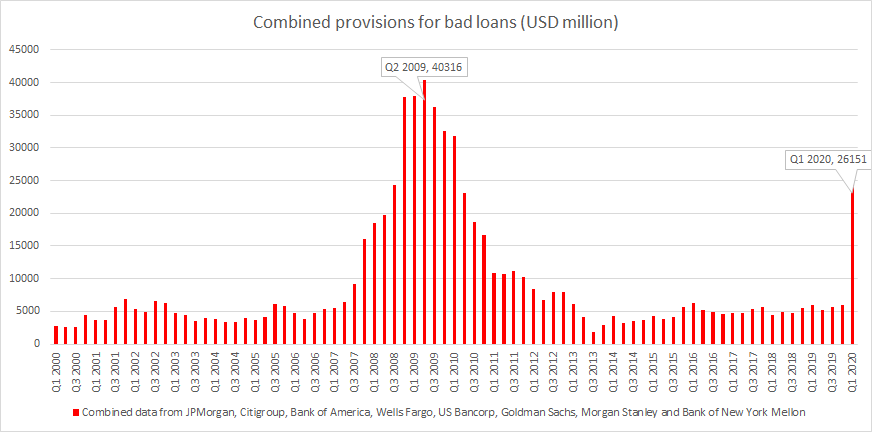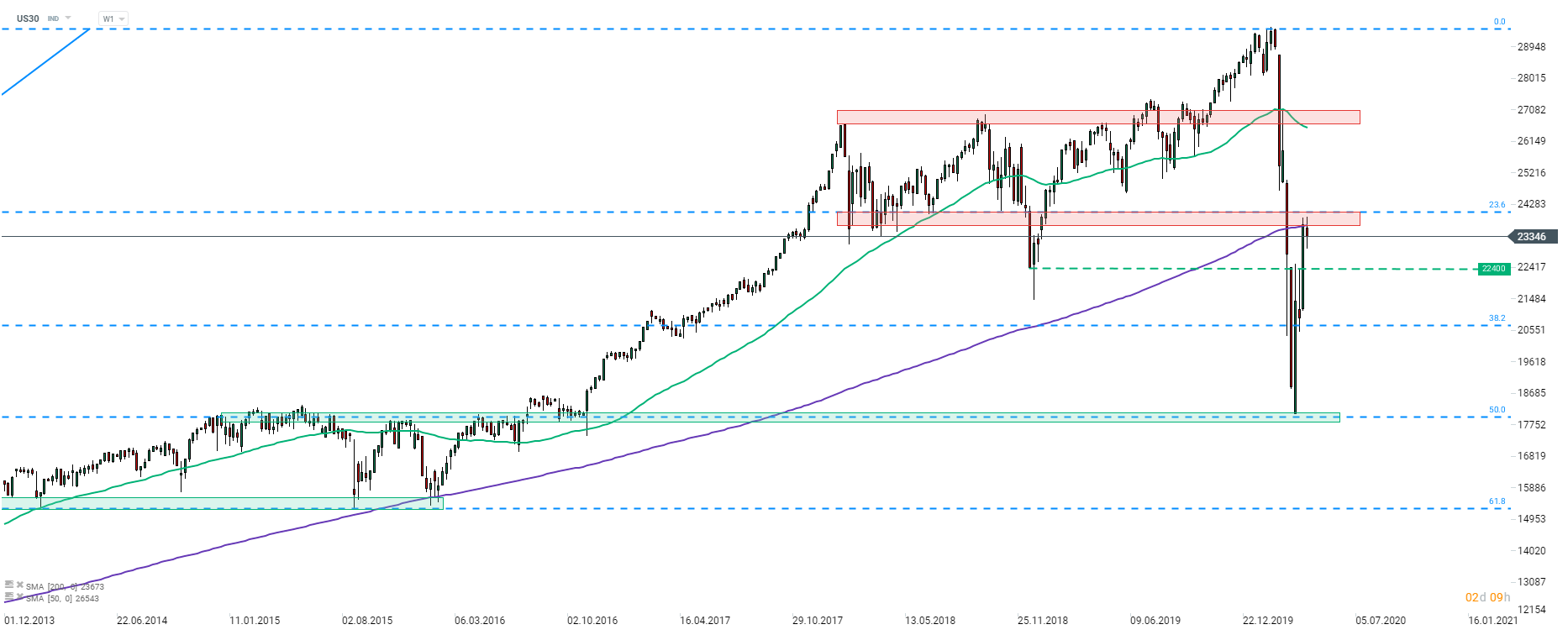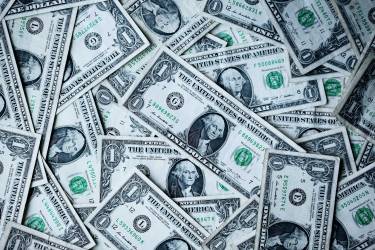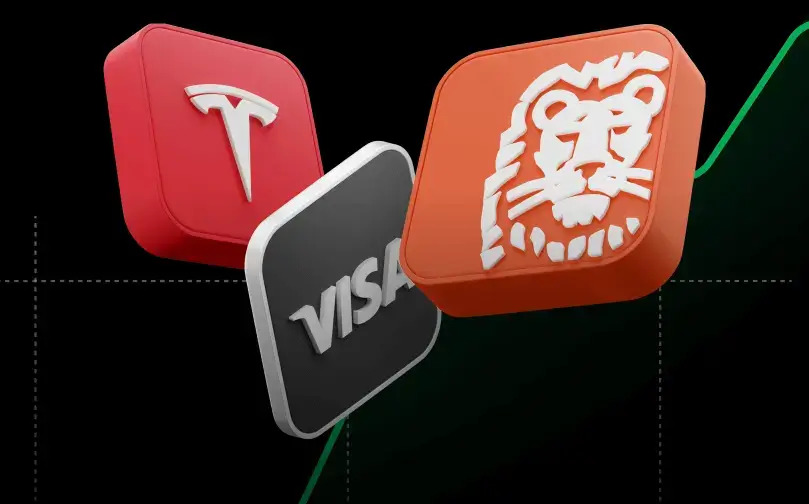-
Banks launched Wall Street earnings report
-
Earnings lower than year ago in most cases
-
Massive increase in provisions for bad loans
-
Dow Jones (US30) pulls back from 200-week moving average
US banks launched Q1 2020 earnings season on Wall Street this week. Investors were served reports from behemoths like JPMorgan (JPM.US) or Goldman Sachs (GS.US). In this short commentary we will take a look at these reports in more detail and focus on issues that may tell us a bit more about the ongoing crisis.
Headline results? Forget about them
Usually investors focus on headline results, like revenue or EPS, and how they compare to estimates. However, they will not have much of an impact as analysts' estimates are more like guesses than forecasts this time. We have elaborated more on the topic in our last week's Stock Market Comment (released on Thursday, April 9). This was the case for banking reports already released as no one seemed to care about top or bottom line and focused on details instead. However, just for the record we will provide a table with headline results below. As one can see, most big US banks saw EPS drop year-over-year. However, some managed to boost revenue compared to Q1 2019.
 Most of the US banks generated lower earnings in Q1 2020 than in Q1 2019. Source: Bloomberg, XTB Research
Most of the US banks generated lower earnings in Q1 2020 than in Q1 2019. Source: Bloomberg, XTB Research
Provisions for bad loans soar!
We have said that focus was on details. What details? Provisions for bad loans. This measure shows how much money the bank has set aside for future defaults on loan portfolios. In turn, changes to provisions can be seen as a hint on what the bank expects. Unfortunately, provisions spiked in the first quarter of 2020. Combined data from 7 banks shows provisions jumped to above $26 billion. This is still far off the financial crisis peak at $40 billion. However, note that back then provisions peaked in the Q2 2009 - at the very end of a crisis. Meanwhile, we are probably at the very beginning of a coronavirus crisis.
As a word of caution it should be said that accounting rules changed this year and banks are expected to make provisions for bad loans much sooner than previously. This could have magnified the increase in provisions in Q1 2020 but one should not fool himself that in the absence of rules change the spike would not occur.
 Provisions for bad loans soared in Q1 2020. However, they are still far off the peak from the global financial crisis. Source: Bloomberg, XTB Research
Provisions for bad loans soared in Q1 2020. However, they are still far off the peak from the global financial crisis. Source: Bloomberg, XTB Research
Consumers look to be more at risk
While not every bank provides a breakdown on segments to which provisions are allocated, some do provide such data. A look at such breakdowns from JPMorgan or Citigroup may be a source of surprise. JPMorgan reported a $6.8 billion increase in loan provisions this quarter with almost 70% of this increase allocated to the consumer segment. Provisions for Citigroup increased $4.6 billion this quarter with over 60% allocated to the consumer unit. Provisions for corporate loans were set up primarily for the energy and entertainment sectors, what should not surprise. This shows that lenders are more worried about consumers not repaying debt rather than corporations as provision breakdown does not reflect revenue breakdown (JPMorgan and Citigroup generate more revenue from corporate segment rather than consumer). On one hand, disproportion can be reasoned with fiscal stimulus measures that are focused on companies and may limit corporate defaults. On the other, private consumption is a backbone of the economic growth and worsening position of consumers is always a warning signal.
What's the picture of the US economy in banking reports?
Summing up, earnings reports from major US banks do not paint a bright picture of the US economy. Big increase in provisions for consumer defaults seems to be justified given massive lay-offs in the US economy. However, one should keep in mind that setting up reserves for loan defaults became even more subjective after accounting rules changed and, in turn, banks have more freedom to manipulate it. Having said that, it cannot be completely ruled out that some banks decided to inflate provisions this quarter in order not to do it in the coming quarters. PR could have also played a role here as showing billions in profits at times when millions are losing jobs could attract bad publicity. When it comes to market reaction, reports from banks can be seen as eye-opening as US indices halted upward move on Tuesday after first releases.
 Banks (JPMorgan and Goldman Sachs) make up around 8% of Dow Jones (US30) weight. Lacklustre earnings reports set a downbeat tone for the week causing the index to pullback from the resistance zone marked by 23.6% Fibo level of the post-2009 rally and 200-week moving average (purple line). Support to watch can be found in the vicinity of 22,400 pts - area that clustered weekly highs for weeks starting March 15, March 22 and March 29 as well as low from mid-December 2018. Source: xStation5
Banks (JPMorgan and Goldman Sachs) make up around 8% of Dow Jones (US30) weight. Lacklustre earnings reports set a downbeat tone for the week causing the index to pullback from the resistance zone marked by 23.6% Fibo level of the post-2009 rally and 200-week moving average (purple line). Support to watch can be found in the vicinity of 22,400 pts - area that clustered weekly highs for weeks starting March 15, March 22 and March 29 as well as low from mid-December 2018. Source: xStation5
The mood for markets shifts, as risk aversion takes hold
US100: Wall Street's stronghold of growth❓
US focus: three things to watch this week
US100 loses 0.5% 📉Meta shares decline extends on AI CAPEX worries & Deutsche Bank remarks
This content has been created by XTB S.A. This service is provided by XTB S.A., with its registered office in Warsaw, at Prosta 67, 00-838 Warsaw, Poland, entered in the register of entrepreneurs of the National Court Register (Krajowy Rejestr Sądowy) conducted by District Court for the Capital City of Warsaw, XII Commercial Division of the National Court Register under KRS number 0000217580, REGON number 015803782 and Tax Identification Number (NIP) 527-24-43-955, with the fully paid up share capital in the amount of PLN 5.869.181,75. XTB S.A. conducts brokerage activities on the basis of the license granted by Polish Securities and Exchange Commission on 8th November 2005 No. DDM-M-4021-57-1/2005 and is supervised by Polish Supervision Authority.


